Propolis Offers Countless Health BenefitsPropolis is well known for its numerous therapeutic properties as a powerful antioxidant and antibacterial, as well as having curative, analgesic and anti-inflammatory properties. However, it must meet three specific criteria. Here’s why. Propolis is composed of 50 to 55% resins and balms, 30% waxes and fatty acids, 10% essential oils, 5% pollen and 5% various organic compounds. Among the latter are flavonoids and other phenolic by-products including their esters, minerals (iron, calcium, zinc, copper, manganese), and vitamins (C, E and B vitamins). 1. In Europe there are two methods for collecting propolis: by scraping it from the hive or by using traps. Beekeepers either scrape the propolis from the frames of the hive, or use types of screens as traps. In the second method, the traps - or screens - are placed on top of the hive, above the frames. The traps are placed in the springtime and removed in September. This produces a fresh propolis, rich in active ingredients, unoxidized and with very little hive detritus. Scraped propolis comes from scraping the propolis from the hive frames. It will contain residue from products used to treat the hive, wax and other toxic elements. Unfortunately, this kind of propolis is sold by a number of different brands. And even propolis scraped from organic hives will contain many pollutants, and this is even more so the case if the hives are old. We believe this kind of propolis should be discarded. Plus, there is little to no chance this information will be mentioned on the propolis packaging - of course not! And those who sell scraped propolis don’t brag about it, either... 2. The botanical origins of propolis is what makes it so special There exist several types of propolis depending on the plant life present in the geographical zone the hives are located in, on the availability of plants during the harvesting season, and the bee species. For example, poplar-type propolis has a very broad spectrum of action on the immune system, with over 300 different types of polyphenols. As for propolis from Baccharis Dracunculifolia, which is highly used in oncology in Japan, it contains a unique polyphenol called artepillin C. 3. Always check the label to make sure it includes dosages of active ingredients (polyphenols). If a propolis contains 25 % or 30 % polyphenols, it’s pure magic! Unfortunately, there is no law mandating this to be included on the label. Also be sure to check that the label indicates that the propolis is free of heavy metals or pesticides. And beware of brands who don’t include this information! WHY IS THE PROPOLIS PRODUCED by ARISTÉE® SO EFFECTIVE? Aristée® propolis which comes from specific botanical origins offer high concentrations of protective substances. Used by bees to seal and sanitize their hives, propolis contains compounds, mainly polyphenols, such as flavonoids, phenolic acids, aromatic acid esters and essential oils. For humans, this combination of sanitizing substances naturally contributes to the body’s protection and resistance. PROPOLIS - AN ANTI-INFECTIOUS AND SANITIZING SUBSTANCE Bees collect this resinous mixture from certain plants and transform it to seal and sanitize their hive or use it to embalm dead insects they cannot get rid of. The therapeutic benefits of propolis have been known for millennia and it was already used in antiquity to embalm mummies. Modern science has dubbed propolis “nature’s antibiotic” and has demonstrated its numerous qualities including antimicrobial, antibacterial, antiviral and antifungal activities. HARVESTING METHODS WHICH GUARANTEE THE EXCEPTIONAL QUALITY OF EARLY PROPOLIS The harvesting method is a determining factor in the quality of propolis. Often collected by scraping the hive frames, this technique does not render quality propolis. Pollenergie applies very specific harvesting techniques, using grids to collect poplar-type propolis, and strips to collect green and red propolis. This ensures a propolis of the highest quality by reducing the effects of oxidation caused by aging, and limiting the presence of residues from treatment products. It guarantees that a maximum of active ingredients have been preserved in the process. BOTANICAL ORIGINS: DIFFERENT MODES OF ACTION Propolis gains its distinctive properties based on its botanical origins which give it specific and unique qualities. Each botanical species produces organic compounds, polyphenols, which play a role in their defense mechanism. These have different chemical structures which will engender differences in absorption, and more importantly, varying modes of action on one same biological target. ACTION & ACTIVE INGREDIENTS OF PROPOLIS by Aristée® Propolis mostly contains polyphenols, such as flavonoids, phenolic acids, aromatic acid esters and essential oils. This combination of natural sanitizing substances contributes to the body’s defenses and resistance. Scientific studies have demonstrated the antimicrobial, antiviral, antifungal, immunomodulatory and anti-inflammatory activity of propolis, making it a strong ally in the fight against a number of infections. How to Choose the Right Propolis 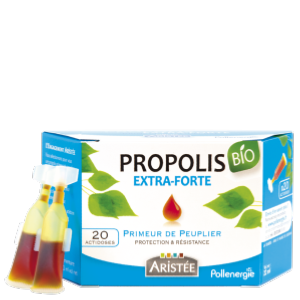 Extra Strength
Propolis Doses Poplar-type propolis Hydroalcoholic form. For adults and children over the age of 12. Guaranteed 95 mg polyphenol content per dose Uses
Directions for use Take propolis on its own, mixed with honey or on top of a solid food item.
Preventive treatment: 1 dose/day for 20 days
Supportive treatment: 3 to 4 doses/day for 3 days minimum 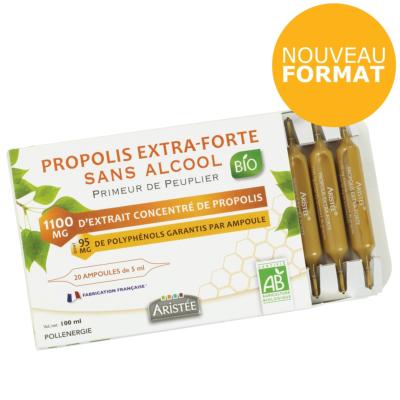 Extra Strength
Propolis Doses Poplar-type propolis Water-soluble form, alcohol-free. Recommended for pregnant women and children ages 2 and above. Guaranteed 95 mg polyphenol content per doseUses
Directions for use Take propolis on its own, mixed with honey or stirred in a cold liquid.
Preventive treatment: 1 dose/day for 20 days
Supportive treatment: 3 to 4 doses/day for 3 days minimum 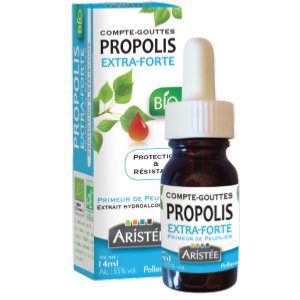 Extra-Strength
Propolis Dropper Bottle Poplar-type propolis Hydroalcoholic Form. For adults and children over the age of 12. Propolis with 9.5% polyphenol concentrationUses
Directions for use Internal use: 2 to 4 pipettes/day for 20 days for prevention; up to 8 pipettes/day as a supportive treatment
External use: 1 drop applied locally on affected area using a cotton swab. Repeat 3 times/day if necessary 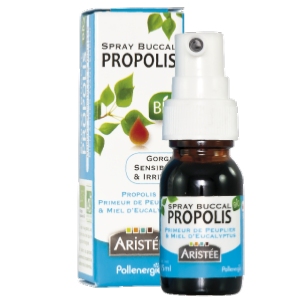 Extra-Strength Propolis
& Eucalyptus Honey Spray PPoplar-type propolis Hydroalcoholic form. For adults and children over the age of 12. Propolis with 8.5% polyphenol concentrationUses
Directions for use 2 to 3 sprays in the back of the throat
Repeat 3 to 4 times/day if necessary
Shake well before use 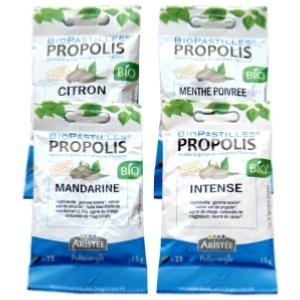 Organic Extra Strength Propolis Lozenges Poplar-type propolis Recommended for adults and children ages 3 and up. Lozenges with 15 mg to 30 mg propolis concentrationUses
Directions for use 5 to 6 lozenges/day; let lozenges melt on the roof of the mouth to extend the release of their natural benefits. 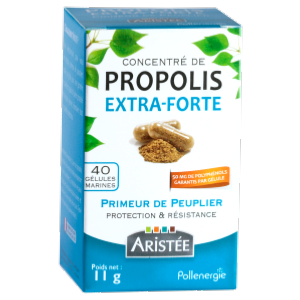 Extra Strength
Propolis Capsules Poplar-type propolis Micronized form suitable for the whole family. The capsule can be emptied and mixed with food (yogurt, fruit compote). Guaranteed 50 mg polyphenol content per capsuleUses
Directions for use Preventive treatment: 2 capsules/day for 20 days
Supportive treatment: 4 to 6 capsules/day
Administer half the dose for children under the age of 12. 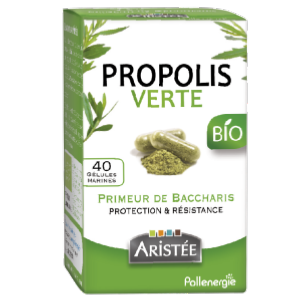 Green Propolis
Capsules Propolis from Baccharis Micronized form. Guaranteed 40 mg polyphenol content per capsuleUses
Directions for use Preventive treatment: 2 capsules/day for 20 days Supportive treatment: 4 to 6 capsules/day Administer half the dose for children under the age of 12. 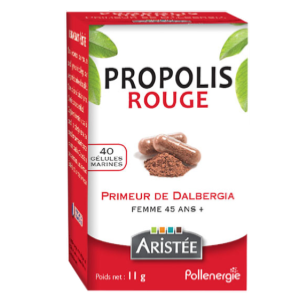 Red Propolis from Dalbergia
Capsules Propolis from Dalbergia Micronized form. Guaranteed 22 mg polyphenol content per capsuleUses
Directions for use 3 capsules per day for one month minimum.
Best taken at the end of a meal |
